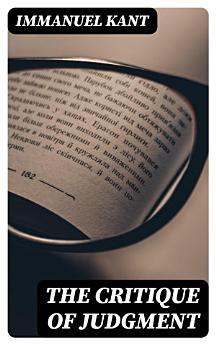The Critique of Judgment
Immanuel Kant
2022. máj. · DigiCat
E-könyv
423
Oldalak száma
family_home
Használható
info
reportAz értékelések és vélemények nincsenek ellenőrizve További információ
Információk az e-könyvről
In "The Critique of Judgment," Immanuel Kant meticulously explores the intricate relationship between aesthetics and teleology, positioning judgment as a critical faculty that bridges the domains of the sublime and the beautiful. This seminal work is divided into two main sections, the Critique of Aesthetic Judgment and the Critique of Teleological Judgment, offering profound insights into the nature of human perception and the principles governing our appreciation of art and nature. Kant employs a distinctive philosophical style, combining rigorous analysis with eloquent prose, reflecting the Enlightenment's quest for objectivity and universality amidst subjective experiences. Immanuel Kant, a central figure in modern Western philosophy, was significantly influenced by the Enlightenment ideals of reason and freedom. Writing "The Critique of Judgment" in 1790, he sought to bridge the gap between empiricist and rationalist thought, examining how aesthetic values and notions of purpose resonate within human consciousness. Kant's rich intellectual heritage, including his engagement with the works of Rousseau and Hume, profoundly shaped his inquiries into the aesthetic and teleological dimensions of human experience. This book is essential for those interested in philosophy, art, and science, offering a fundamental understanding of how we evaluate and appreciate beauty and purpose. Readers will find Kant's reflections not only intellectually stimulating but also highly relevant to contemporary discussions surrounding aesthetics and the nature of judgment.
A szerzőről
Immanuel Kant, born April 22, 1724, in Königsberg, then part of Prussia, is one of the most influential philosophers in the history of Western philosophy. His comprehensive and systematic work in epistemology (the theory of knowledge), ethics, and aesthetics greatly influenced all subsequent philosophy, especially the various schools of Kantianism and idealism. Kant's endeavor to set out to the limits of metaphysics and understanding led to what is often considered his greatest work, 'The Critique of Pure Reason' (1781/1787), establishing his reputation as a foremost thinker. His 'The Critique of Practical Reason' (1788) is central in his moral philosophy, whilst 'The Critique of Judgment' (1790), the third of his seminal triad, delves into aesthetics and teleology. It bridges the gap between the natural world and the moral world, providing a comprehensive framework for his aesthetic theory, notably his analyses of beauty and the sublime. Kant's critical style of philosophy was aimed at solving what he perceived as shortcomings of past doctrines, setting the stage for many philosophical debates that would follow. He passed away on February 12, 1804, in Königsberg, where he had lived all his life, but his writings continue to resonate and shape philosophical discussion today.
E-könyv értékelése
Mondd el a véleményedet.
Olvasási információk
Okostelefonok és táblagépek
Telepítsd a Google Play Könyvek alkalmazást Android- vagy iPad/iPhone eszközre. Az alkalmazás automatikusan szinkronizálódik a fiókoddal, így bárhol olvashatsz online és offline állapotban is.
Laptopok és számítógépek
A Google Playen vásárolt hangoskönyveidet a számítógép böngészőjében is meghallgathatod.
E-olvasók és más eszközök
E-tinta alapú eszközökön (például Kobo e-könyv-olvasón) való olvasáshoz le kell tölteni egy fájlt, és átvinni azt a készülékre. A Súgó részletes utasításait követve lehet átvinni a fájlokat a támogatott e-könyv-olvasókra.








